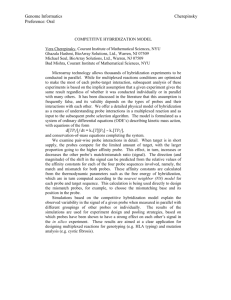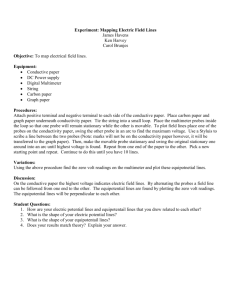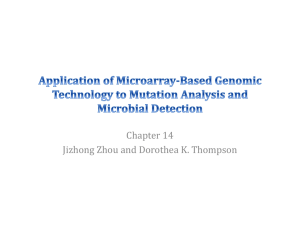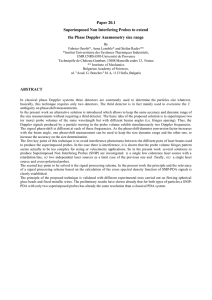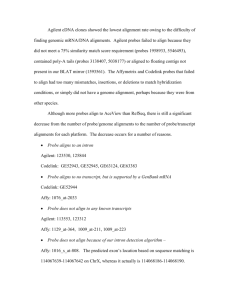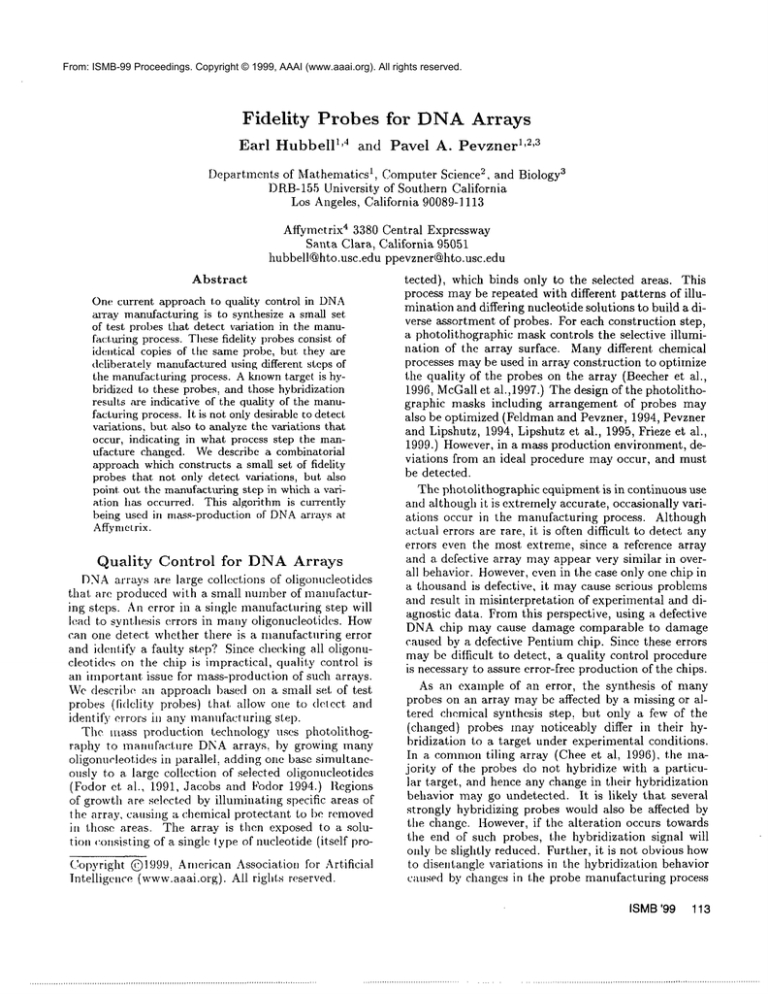
From: ISMB-99 Proceedings. Copyright © 1999, AAAI (www.aaai.org). All rights reserved.
Fidelity
Earl
Probes for DNAArrays
Hubbell 1’4 1’2’
and 3Pavel
A. Pevzner
Departments of Mathematics l, Computer Science 2, 3and Biology
DRB-155University of Southern California
Los Angeles, California 90089-1113
Affymetrix 4 3380 Central Expressway
Santa Clara, California 95051
hubbell@hto.usc.edu ppevzner@hto.usc.edu
Abstract
One current approach to quality control in DNA
asTay manufacturingis to synthesize a small set.
of test probes that detect variation in the manufacttwing process. Thesefidelity probes consist of
identical copies of the same probc, but they are
deliberately manufacturedusing different steps of
the manufacturingprocess. A Mlowntarget is hybridized to these probes, and those hybridization
results are indicative of the quality of the manufacturing process. It is not only desirablc to detect
variations, but. also to analyze the variations that
occur, indicating in what process step the manufacture changcd. Wedescribe a combinatorial
approach which constructs a small set of fidelity
probes that not only detect variations, but also
point, out the manufactltringstep in whicha variation has occurred. This algorithm is currently
being used in mass-production of DNAarrays at
Affymetrix.
Quality
Control
for DNA Arrays
DNAarrays are large collections of oligonucleotides
that arc produced with a small number of lnanufacturing steps. An error in a single manufacturing step will
lead to sym.hesis errors in manyoligonucleotides. How
can one detect whether there is a manufacturing error
and identify a faulty step.’? Since checking all oligonucleotides on the chip is impractical, quality control is
an irnportant issue for mass-l)roduction of such arrays.
Wedescribe a.n approach based on a small set of test
probes (fidelity probes) that allow one to detect and
identify errors in any naa.nufacturing st.ep.
The mass production technology uses photolithography to manufacl.ure DNAarrays, by growing many
oligonucleotides in parallel, adding one base simultaneously t.o a large collection of selected oligonucleotides
(Fodor et al., 1991, Jacobs and Fodor 1994.) Regions
of growth are selected by illulninating specific areas of
t he array, causing ~ chemical protectant to be removed
in those areas. The array is then exposed to a solution ,xn,sisting of a single lype of nucleotide (itself proC, opyright @1999,American Association for Artificial
lntelligelwe (www.aaai.org). All rights reserved.
tected), which binds only to the selected areas. This
process may be repeated with different patterns of illumination and differing nucleotide solutions to build a diverse assortment of probes. For each construction step,
a photolithographic maskcontrols the selective illumination of the array surface. Manydifferent chemical
processes may be used in array construction to optimize
the quality of the probes on the array (Beecher et al.,
1996, McGallet a1.,1997.) The design of the photolithographic masks including arrangement of probes may
also be optimized (Feldman and Pevzner, 1994, Pevzner
and Lipshutz, 1994, Lipshutz et al., 1995, Frieze et al.,
1999.) However, in a mass production environment, deviations from an ideal procedure may occur, and must
be detected.
The photolithographic equipment, is in continuous use
arid although it is extremely accurate, occasionally variations occur in the manufacturing process. Although
actual errors are rare, it is often difficult to detect any
errors even the most extreme, since a reference array
and a defective array mayappear very similar in overall behavior. However,even in the case only one chip in
a thousand is defective, it may cause serious problems
and result in misinterpretation of experimental and diagnostic data. Fromthis perspective, using a defective
DNAchip may cause damage comparable to damage
caused by a defective Pentium chip. Since these errors
maybe difficult to detect, a quality control procedure
is necessary to assure error-free production of the chips.
As an example of an error, the synthesis of many
probes on an array may be affected by a missing or altered chemical synthesis step, but only a few of the
(changed) probes may noticeably differ ill their hybridization to a target under experimental conditions.
In a commotl tiling array (Chee et al, 1996), the inajority of the probes do not hybridize with a particular target, and hence any change in their hybridization
behavior may go undetected. It is likely that severM
strongly hybridizing probes would also be affected by
the change, ltowever, if the alteration occurs towards
the end of such probes, the hybridization signal will
only be slightly reduced. Further, it is not obvious how
to disentangle variations in the hybridization behavior
cat,sed by changes in the probe mamffacturing process
ISMB ’99 113
from natural variations occurring within an experiment.
Per stringem quality cont.rol, it. is desirable to detect
variations in t.he normal mamffacturing process before
they st.ray from ac.coptable limits and cause actual errors. For this purpose as well, it is important to have
a method of analyzing process variation independent of
the actual experimental use of the array. It is important
to detect, that a manufacturing step has varied, and in
addition, it. is valuable to determine in which particular
manufacturing step a variance took place. Detecting
the specific step at which a variation occnrs allows one
to more easily diagnose the sin,roe of any malmfacturing
difficulty.
One naethod of performing this diagnosis is to con>
pare a test set of probes of Mentical sequence that
are produced using different manufacturiug steps. If
this set. is sufficiently diverse, every manufacturingstep
error should have a unique signat.ure of affected test
probes. The computational challenge in fidelity probe
generation is to find a small, yet diverse, collection
of ways to synthesize an oligonucleotide sequence using different manufacturing steps. Wehave solved this
problem by finding a small and diverse set of paths in
an acyclic graph similar to the dynamic programming
graph for sequence alignment. Randorn generation of
such paths does not produce a small set meeting our
requirements for diversity, and so we propose a deterministic approach that works well in practice. To the
best. of our knowledge, problems of this type have not
been examined before in co,nputationa[ biology and the
algorithm below outlines one solution as described in
the resulting patent application.
Fidelity
Probe Generation
The manufacturing process is described by a manufacturing protocol, S = $IS2...S~, which is a string
over the alphabet, A,T,G,C, with Si corresponding to
the nucleotide added in the ith manufacturing step.
Any subsequence of S may be syr, thesized at a given
address using the photolithographic process. Usually,
manydifferent subsequences of the protocol correspond
to a given sequence p = PlP’_,...Pt.
We call these
different subsequenees p-svbscquences in S. F’or example, given the protocol
S = ACGTTACGT, and
the desired probe sequence p = ACGT, the six possible p-subsequencesin S are { S1S2,5’3,~.1,
,ql,5’2S3S5,
$1S2,%$9,
S1S2,~8,~’9,
,.5"1S7,5’gS9,
$6,~7~.b~8S9
}.
|n
each
p-subsequenee, the monomers A,C,G,T are added in
that order t.o produce the probe ACGT,but. different
manufacturing steps are used.
Since all p-subsequences construct the salne oligomer
15, addresses corresponding to different p-subsequences
should have similar hybridization behavior. If similar
behavior is not seen, then the manufacturing protocol has varied in some step. ’l’herefore, we may use
an appropriately chosen set. of p-subsequences to detect variation in the manufacturing protocol. Given
a set of p-subsequences, FP, define the subset of 15subsequenccs that use the letter S/ to be Pi. This sub114 HUBBELL
set. consists of those p-subsequencesthat ;u’e atre.cted
by variations in the step i. If those subsets /~ are o.ach
unique, a change in any single step i of the manufacturing protocol will have a unique signature of affected
p-subsequences which allows one t.o find the erroneous
step. In practice, we want to desigu p-subscquence.s to
fill a reserved set of N addresses, so that ewwystep
in the protocol S is represented several tiJ~tes (required
for good statistics.)
Therefore we have a chosen parameter, Minb’izc, determining the minimumnumber
of p-subsequences affected by each mant,facturing step.
To ensure thai. ever)’ stop has a unique signature (set
of addresses that respond when it varies), we require
a parameter Mir, l)iff, indicating the ,niniinum number
of dilferences between every pair of s~ts Pi and I ). to
count them as ’unique’.
Fiddity Probe Generation Problem. (liven a protocol
S, a probe p, a number N, and eol,straints ..].[mSizc,
MinDiJ]~lind N different p-subsequencesin S’ such that.
¯ I Pi I >Min,s’iz( for 1 < i < s
¯ ] Pi \ Pj [>_ MinDiff for 1 _< i 7~ j < s
While the fidelity probe generation problem could be
formulated as a minimizatiou problem in N, we prefer
l.lle formulation above sin’e in practice the uumberiX;
is a fixed constant. Note that l.his formulation of the
problem assumes that every S’i cart be present in some
set of l,-subsequences. T’his is false in general, and in
this c~e, the algorithm reports that there is uo auswel’.
eXt. first glance, it seemsthat a sirnple approach that
generates p-subsequences randomly would satisfy the
constraiuts. Although for s,fficiently
large N such a
naive strategy may succeed, for practical values of N,
,’~Iin,f,’ize, and MinDiff, our computationalexperiment.s
demonstrate that a.t least one of our constraints is violated under this approach. Therefore a more sophisticated approach is required.
Algorithm for Fidelity Probe
Generation Problem
The problem with t, he naive "random choice" approach
is that each additional p-subsequence generat, ed only
makes a small contribution towards satisfying our MinSize and MinDiffconstraints, and thus loads to an excessive number of fidelity probes N. "l’hus, we wish
to bias the selection procedure so that each additional
p-subsequence makes a largo collt.ribution towards satisfying our constraints. A compact method of representing all possible p-subsequencesis to construct a directed acyclic graph similar t.o the dynamic progranruing graph for sequence alignment. The dyuami," programmingmatrix for p-subsequences in ,b’ is set. up
between the probe, p, aud the ,nanufacturing protocol, b’ (Fig.l). The correspomling dynamic programrning graph contains all horizontal edges, and diagonal
edges from (i- 1,j- 1) to (i,j) if Pi = ,5’.i. Every
path from (0, 0) to (t,.s) in this directed aeycli,: graph
corresponds to a possible p-subsequence. Since generation of p-subsequences by finding random paths in
DAG for
S = ACGTTACGT,
p=ACGT
Paths corresponding
to subsequences
N = 6, MinDiff - i, MinSize = 1
ACGTTACGT
ACGT .....
---A ..... CGT ........
ACG . T .........
ACG
..... T
.....
ACGT
AC .....
A
C
G
GT
T
-- -~
"°
T
°~
A
C
G
T
-",--.¯
..............................................
,
,
J
A,I’-:.~"..~.
°o’._%.",.
..........
=-’-.". %
¯ %%~
i
-’.>’..k-.~
"R:..¯
.,
-.
"..%.~
~...¯
,.,
~... ¯
". _.~~....,., ...........................
’,
"’:k-.~.
".N-.¯
,
"’.¯~’~
"-?’<’-.¯
I,
._~’~-.........
-. :~’..¯
G
-...:~.~.\
"’.~Q’-5~
’,
..............................................
"*’~-~-,..
-.-.~’,
J
Figure] : Diversepathsin DAG
generatefidelity probes
this DAGdoes not produce a feasible solution, we suggested the idea of"reweighting" this graph. Given a set
of p-subsequencesthat partially satisfy the constraints,
we want to weight, the edges of this graph so that the
shortest such path produces a new p-subsequence that.
helps us satisfy" the constraints. The newly generated
p-subsequence is added to our set, and the DAGis
reweighted. Each iteration of this procedure should
add a p-subsequence that satisfies new aspects of our
constraints.
Thus, we nmst lind a method for choosing weights that causes the shortest path to differ from
previous p-subsequences.
Weighting the graph has some sul)tle aspects. A natural strategy to satisfy the M.inSize constraint is to
weight edges in the graph with the number of times
each edge is used in p-subsequences. Repeated generation of p-subsequences corresponding to a shortest path
in the DAGwith the DAGreweighted every time a psubsequence is generated should produce a diverse set
of p-subsequences. However, this natt,rM strategy does
not produce a smMlset of p-subsequenccs that satis~’
our conditions, because manydifferent edges may correspond to the same synthesis step. It is necessary to
explicitly include our conditions in the weighting strategy. For example, weighting the edges corresponding to
manufacturing steps Si that have been used more than
,llinSize times antolnatically causes the shortest path to
pass through a maximal number of unweighted edges,
and hence constructs a p-subsequencc that assists us towards satisfying our 211inSizc constraint. An improved
strategy is to weight the edges based on the number of
times the corresponding manufacturing step ,gi is used.
Using this improved strategy, repeated generation of
p-subsequences will gradually satisfy the ,14inSize condition.
Unfortunately, our MinDiffcondition may not be satisfied by this procedure. In order to make progress towards satisfying our MinDiff condition, two lnanufacturing steps Si and S’j are chosen for which the condition is not satisfied. The subroutine of the algorithm
SplitSteps, reweights two such manufacturing steps to
encourage one and discourage the other. It is important that the revised weights arc not rewcighted to have
the same sum as before, because then the shortest path
could use both edges and pay no penalty. A further difficulty is that often there are correlations betweensteps
so that using one step Si in a p-subsequence forces the
use of another step Sj. To avoid this difficulty, if the
previously generated set of p-subsequences has an even
number of menlbers, Si is encouraged, and if it has an
odd number of members, Sj is encouraged. In this manner, even if Sj is discouraged, but Si forces the use of
5~ so that progress is not made towards the MinDiff
condition, the next iteration of the algorithm will encourage the use of Sj and discourage ,5’i and so make
progress towards satisfying the MinDiff constraint. If
the MinDiff condition is satisfied for all pairs of steps,
then SplitSlcps chooses a step that has been used in the
fb.west p-subsequences and encourages that step, while
discouraging a step that has been used in the most
p-subsequences. In the code, the manufacturing step
that is encouraged has the weights of the corresponding edges reduced by 2xLARGEand the discouraged
manufacturing step has the corresponding weights increased by LARGE,where LARGEis a large constant.
Surprisingly, under several reweighting strategies, repeated generation of shortest paths often produces
paths duplicating a previous path. Since we are looking
for a set of distinct p-subsequenccs, a simple reweighting
scheme’FabuSca~vhis used t.o guarantee the uniqueness
of each chosen p-subseqnence. In this reweighting strategy, those manufacturing steps used by the duplicate psubsequence are increased in weight, and a replacement
p-subsequence is generatod. This procedure is iterated
until a. distinct p-subsequence is created, or LOOPMA
X
iterations have occurred. If LOOpe~IAX
iterations occur, the subroutine returns a duplicate p-subsequence,
and hence the set of p-subse(luences l)roduced will not
haw~distincl, membersand the algorithm will return no
solution found.
ISMB ’99 115
Specifically, a set. of fidelity probes meeting our conditions are constructed by FidelityP.robe,
the following
algorithm. At (,very iteration,
we start with tile set FP
consisting of the p-subsequenees already constructed,
and l)rocluce the p-subsequence PR. Pi is the subset of
F P which uses the manufacturing step b’i. The directed
a.cyclic grapl, DAGis constr,cted
as described above.
The set ofe(lges t~.j correspondil,g to the manufacturing
step ,5) arc those edges (i - 1, j - I) to (i, j) in tile
column of the D..4(; where pi = ,b.’j. Because each edge
in this set Ej corresponds to the same manufacturing
step, each such edge has the same weight assigned to it.
as all other edges il, E.i. These weights are tracked by
the variable I.l.’~ight[j],
corresponding 1.o t.he identical
weight a.ssigned to each edge within N.j.
FidclityProbc(p,S, N, Min.Diff, MinSizc)
FP+--O
fork+- I Los
P~+-O
g, en(..rat.e DAGcorresponding to p and 5’
while ] t"l-’ l< N
for k +-- 1 to s
IVc.igm[k] +-I P~ I
Nplit£h7)s( D AG. F’P)
t"P +-- FPU { 7hbuScarch(DA(;.FP)
if I"P satisfies fidelity probe requirements
out.put I"P
else,
ottt,
l)ut.
" no solution
found"’
,%’plitSteps( l) AG,F
if exists i # j such thatl t’, \/~ I< Mi,zDiff
if I FPlis even
W,:i.qht[i] +- Weight[i] + LARGE
Wright[j] +-- Hq ight[j] - 2 ¯ LARGE
else
Weight[j] +--Wcight[j ] + L.ARGE
IVeight[i] +- I.Vc.i.qht[i] - 2 * LARGE
else
Find i 7~ j suchthat [ 1~ [ is minimal
and ] /-’,[is maximal
Wright[i] ,,- ll.’ci.qht.[i] - 2 * LARGF.,
l.’Vciflht[j]
+-- W,’igh@] + LARGE
return
7[hbu.%a,’ct~(
I)..1(;, I"1’)
c+--O
repeat
PR ~ Sho,’tcst.l’ath(
DAG)
if PH6 i"1’
tbr k +-- I to .s
if ,b’k 6 PR
W,.ight[k] +-- Weight[k] +1
c+-c-F
l
until PR ¢- FP or ,:’ _> I.O01L’IlAX
for k +-- I t.o s
if’ PR uses step k
I’~, +-- l’k u {Pit}
return P R
116
HUBBELL
Conclusion
"I’his Mgorithnl has several hclpflll properties. First, it. is
deterministic, so that it produces the sa, ne set. of fidelity
probes for identical maimfacturing protocols. ,qecond,
the 7hbuSeawh routine may be easily modified to avoid
any pre-specified set of p-subsequences. The first property is valuable because il. allows fidelity probes to be
consistent betweeu different DNAarrays, and tl, ¯ second is yah,able because it allows several diffe..rent
sets
of fidelity probes t.o be generated and compared.
In practice, a DNAarray" is (tesigned to reflect a biological prot)lern and a manufacturing l)rotocol .b’ is (’onst.ruct.ed for the synthesis of that arraty. A prcseleeted
20-mer qnality control target, and the four possible 17mer probes that hybridize perfectly’ to thai. target are
used in the fidelity
algorithm. Obviously, i[’a given
mamlfacturing l)rotocol begins with tile addition of
nlonolner that is not the same as the initial
lnonomer
of the desired probe, there are some cycles in the manufacturing
protocol that cannot be present in any psubsequence. With four different probes, each ()he starting with a different one of the four possible nlouonlers
and ending with a different
one of the four possible
mononmrs, a greater variety of manufacturirlg
t)roto(’ols may be handled. For each of these four probes,
N = 32 p-sul)sequences are generated, utilizing
all cycles in :b’ that can be covered by that prol)e. The finM
set of 123 p-subsequcnces are placed into the reserved
addresses in the array.
This algorithm satisfies
the technological
requirements. A typical manufacturing protocol b’ is 60-100
steps, usually ACGT... ACGT,or a short, edit distance
from such a string. The algorithm produces a set of fi(Mity probes satisfying our requiremeuts from a (.yl)ical
20-mer quality control target.
A number of theoretical questions remain. For example, giver, a typical set
of mamffacturing protocols,
what is a target that can
be used for fidelity testing on any of t.he I)rotocols? Is
there a simple algorithm that solves the problem over a
wider range of protocols and probes thin, this Mgorithm
does’:’
Acknowledgement
The authors are grateful to David Smith for discussions
on the practical aspects of array qualily control, and to
Sridhar Hannenhalli for discussions on the early versions of the algorithm for fidelity probe generation.
References
Bee,’her, .lody 1".: McGall, GleIm H., Goldberg, Marl.iu .I. Cl,emica.l[y Amplified Photolithography for tile
Fabrication of lligh l)ensity Oligonu(:leotide
Arrays.
Pohjm. Mater. Sci. E~79. 76:,5!.)7-598, 1!.)97.
(.:hee, M., Yang, K., l lubbell, E., Berne, A., Huang,
X.C., St.e,’u, D., Winkler, ,l., Lockhart, D.J., Morris,
M.S. and Fodor, S.P.A. Accessing genetic information
with high-density DNAarrays. Science , 274:610-614,
1996.
Feldman, W.. Pevzner, P.A. Gray code masks for
Sequencing by [[ybridization.
Genomics, 23:233-235,
1994
Fodor, S.P.A., Read, J.L., Pirrung, M.C., Stryer,
L., Tsai Ira, A. and Solms, D., Light-directed, spatially addressable parallel chemical synthesis. Science,
251:767-773, 1991.
Frieze, A.M., Preparata, F. P., Upfal, E., On the
Power of Universal Bases in Sequencing by Hybridization. Third Annual International Conference on Computational Molecular Biology, Lyon, France, 1999.
Jacobs, J.. Fodor, S. Combinatorial Chemistry - Applications of Light-Directed Chemical Synthesis. ’l)’ends
h~ Biotechnology 12:19-26,1994.
Pevzner, P.A. and Lipshutz, R.J. Towards DNAsequencing chips. 19th Syrup Math on Foundations in
Computer Sew.nee, Springer-Verla.q Lecture Notes in
Mathematics, 841, 143-158. 1994.
Lipshutz, R..J., Morris, M.S., Chee, M., Ihbbell, E.,
Kozal, M.J., Shah, N., Shen, N., Yang, IL Fodor, S.A.
llsing Oligonucleotide Probe Arrays to Access Genetic
Diversity. BioTechniques. 19:442-447, 1995.
Mc(;all, G., Labadie, J. Brock, P., Wallraff, G.,
Nguyen, T., Hinsberg, W. Light-Directed Synthesis
of lligh-Density Oligormcleotide Arrays Using Semiconductor Photoresists. Proc. Natl. Acad. Sci. U.S.A.
93:13555-1356o, 1996.
ISMB ’99 117


